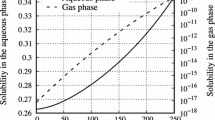Abstract
The purpose of this paper is to report the results of a new model study critically examining the high temperature nuclear waste disposal concept at Yucca Mountain using MULTIFLUX, an integrated in-drift- and mountain-scale thermal-hydrologic model. In addition to new results the paper summarizes results of a previous study. The results show that a large amount of vapor flow into the drift is expected during the period of above-boiling temperatures in the emplacement drift. This phenomenon makes the emplacement drift a water/moisture attractor for thousands of years during the above-boiling temperature operation.
The evaporation of the percolation water into the drift gives rise to salt accumulation in the rock wall, especially in the crown of the drift for about 1500 years in the example. The deposited salts over the drift footprint, almost entirely present in the fractures, may enter the drift either by rock fall or by water drippage. During the high temperature operation mode the barometric pressure variation creates fluctuating relative humidity in the emplacement drift with a time period of approximately 10 days. Potentially wet and dry conditions and condensation on the surfaces over salt-laden drift wall sections are unfavorable to the storage environment. Corrosive salt accumulation during the above-boiling temperature operation must be sufficiently addressed to fully understand the waste package environment during the thermal period. Until the questions are resolved, a below-boiling repository design is favored where the Alloy-22 will be less susceptible to localized corrosion.
Similar content being viewed by others
References
DOE (U.S. Department of Energy)., “Thermal Loading Study for FY 1996.” B00000000-01717-5705-00044 REV 01. Las Vegas, Nevada: CRWMS M&O. ACC: MOL.19961217.0121 (1996).
DOE (U.S. Department of Energy). “Multiscale Thermohydrologic Model”. Prepared by Bechtel SAIC Company, LLC. ANL-EBS-MD-000049 REV 01. Yucca Mountain Project. Las Vegas, Nevada (2004).
Bechtel SAIC Company, “In-drift natural convection and condensation.” Yucca Mountain Project Report, MDL-EBS-MD-000001 REV 00, Bechtel SAIC Company, Las Vegas, NV (2004).
G. Danko, “Coupled Hydrothermal-Ventilation Studies for Yucca Mountain.” Annual Report for Period April 2002 through March 2003. Pahrump, Nevada: Nye County Department of Natural Resources. WRPO-2003-5 (2003).
G. Danko, and D. Bahrami, “Coupled, Multi-Scale Thermohydrologic-Ventilation Modeling with MULTIFLUX” 2004 SME Annual Meeting, February 23–25, Denver, CO (2004).
C. Manepally, and R. Fedors, “Edge-Cooling Effect on the Potential Thermohydrologic Conditions at Yucca Mountain.” Proceedings, 10th Int. High-Level Radioactive Waste Management Conference, pp. 286–292 (2003).
J.T. Birkholzer, S.W. Webb, N. Halecky, P.F. Peterson, and G.S. Bodvarsson, “Evaluating the Moisture Conditions in the Fractured Rock at Yucca Mountain: The Impact of Natural Convection Processes in Heated Emplacement Drifts.” LBNL-59334, Berkeley, CA, Lawrence Berkeley National Laboratory (2005).
DOE (U.S. Department of Energy). “Ventilation Model.” Prepared by Bechtel SAIC Company, LLC. ANL-EBS-MD-000030 REV 01D draft. Yucca Mountain Project. Las Vegas, Nevada (2002).
K. Pruess, C. Oldenburg, and G. Moridis, “TOUGH2 User’s Guide, Version 2.0.” Report LBNL-43134, Lawrence Berkeley National Laboratory, Earth Sciences Division, Berkeley, California (1999).
S. W. Webb, and M. T. Itamura, “Calculation of Post-Closure Natural Convection Heat and Mass Transfer in Yucca Mountain Drifts.” Proceedings of ASME, Heat Transfer/Fluid Engineering, July 11–15, Charlotte, NC (2004).
NUFT. “Flow and Transport Code Version 3.0s.” Software Configuration Management, Yucca Mountain Project – STN: 10088-3.0S-00. Prepared by Lawrence Livermore National Laboratory (2000).
G. Danko, “Functional or Operator Representation of Numerical Heat and Mass Transport Models.” Journal of Heat Transfer, February 2006, Vol. 128, 162–175 (2006).
G. Danko, and D. Bahrami, “Heat and Moisture Flow Simulation with MULTIFLUX”, Proceedings of HT-FED04 – ASME Heat Transfer/ Fluids Engineering Summer Conference, Charlotte, NC (2004).
G. Danko, and D. Bahrami, “Coupled Hydrothermal-Ventilation Studies for Yucca Mountain.” Annual Report for April 2004–March 2005. NWRPO-2005-02, prepared for Nye County Department of Natural Resources and Federal Facilities, Pahrump, NV (2005).
Yucca Mountain Project Technical Database [TDR-NBS-MD-000001, 2000].
J. Birkholzer, “Penetration of liquid fingers into superheated fractured rock” Water Resources Research, Vol 39, No 4, 1102, (2003).
Author information
Authors and Affiliations
Rights and permissions
About this article
Cite this article
Bahrami, D., Danko, G. & Walton, J. Water, Vapor, and Salt Dynamics in a Hot Repository. MRS Online Proceedings Library 985, 1306 (2006). https://doi.org/10.1557/PROC-985-0985-NN13-06
Received:
Accepted:
Published:
DOI: https://doi.org/10.1557/PROC-985-0985-NN13-06




